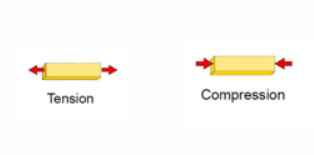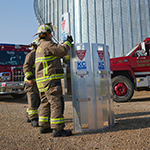Concrete grain bin spalling and repair
Follow these recommendations to help maintain bin integrity and avoid costly bin failure.
Concrete spalls are a common problem that affects many concrete grain storage structures and are a major source of concern for operators. When a spall occurs, operators are left wondering if a serious structural problem exists with their facility.
Failure to address concrete spalling can lead to faster deterioration, worker injury or death caused by falling concrete and other significant consequences, such as catastrophic bin failure.
A concrete spall is a chip, fragment, pop-out or pit in concrete that occurs when internal stresses exceed the tensile capacity of the concrete. Corrosion of reinforcing steel is the leading cause of concrete spalls. When steel corrodes, the resulting rust occupies a greater volume, thereby creating excessive tensile stresses, which can lead to a pop-out in the concrete surface.
 Concrete is an anisotropic material — meaning its strength properties differ depending on the type of structural loading. Concrete is tremendously strong in resisting compressive loads, but relatively poor at resisting tensile loads. Concrete grain structures in service are subject to both compressive and tensile loads.
Concrete is an anisotropic material — meaning its strength properties differ depending on the type of structural loading. Concrete is tremendously strong in resisting compressive loads, but relatively poor at resisting tensile loads. Concrete grain structures in service are subject to both compressive and tensile loads.
Compressive loads in grain storage structures are due to the self-weight of the structure and the friction between the grain kernels and the concrete sidewall. Tensile stresses are due to the piling action of the stored grain (in order to get the grain to stack a confining perimeter must be introduced). This confining perimeter introduces tension into your silo wall.
Because concrete isn’t effective at resisting tensile loads, reinforcing steel bars are embedded within the thickness of the structural members. Normally, unfinished steel is susceptible to rust. But when embedded in concrete, the alkalinity of the concrete provides an effective protective layer that prevents corrosion. Over time, mechanical defects or electrochemical changes to the concrete can negate the protective alkaline layer, eventually leading to corrosion, rust and pop-outs.
At the first sight of spalling, many operators immediately contact a restoration contractor to begin repairs. The problem with this approach is that the root cause of the spalling isn’t investigated and corrected, leading to a reoccurrence of the spalling shortly after repairs have been completed. It’s best to enlist the appropriate professional (licensed engineer or qualified restoration contactor) to identify the exact cause of the concrete spall prior to beginning any repairs. Restoration work should include remediation that addresses the specific cause of the spalling to ensure the ensuing repairs are durable and long-lasting.
Common causes of concrete spalling
- Insufficient concrete cover. Reinforced concrete requires a minimum concrete thickness (i.e., concrete cover) over the steel reinforcing bars. Minimum thickness is needed to protect the steel from environmental elements and to provide thermal insulation. Without adequate cover, thermal gradients can develop and cause hairline cracking at the location of the reinforcing steel. Hairline cracking provides easy and direct access for weather to reach the reinforcing steel, causing deterioration of the steel bars.

Spall caused by insufficient concrete cover over the steel reinforcing.

Multiple vertical and horizontal hairline cracks.
- Chloride contamination. If you’re familiar with roadway deicing salts you may be aware of the affect of chlorides to the steel components of automobiles – rust. Concrete is frequently contaminated by chlorides in two ways. First, when chlorides are added directly into the concrete mix during initial construction to quicken concrete set times. Second, when environmental salts wick their way into the small concrete pores. The latter is common in saltwater costal areas and where deicing salts are frequently applied. An electrochemical reaction occurs in chloride-contaminated concrete which can quickly deteriorate large areas of reinforcing steel.
- Carbonation. Carbon dioxide, which is always present in the atmosphere, can react with water to form a weak acid. Over time, the acid travels though the concrete, eventually reaching the reinforcing steel. Carbonated concrete is no longer alkaline and doesn’t provide protection from corrosion to the reinforcing steel.
Visual examination alone may not give a definitive answer to the root cause of the spalling. Destructive and small scale non-destructive test methods may be necessary to accurately determine the cause of spalling. Owners should consult with a licensed engineer or qualified concrete restoration contractor to determine which test method is appropriate for their specific situation.
Once a root cause has been determined, restoration can begin. If spalling is small and isolated, monitoring the structure for a worsening condition may be the best option. Spalling eventually becomes a structural concern when a significant loss of cross-sectional area has occurred or when reinforcing steel is exposed.
When worker safety is an issue, such as when concrete is either loose or falling, restoration should begin immediately.

Rusting of the above reinforcing bar has not yet reduced the original cross section of the bar appreciably. In this example, a monitoring program may be appropriate rather than immediately pursuing restoration.

Image of a facility with numerous, uniformly distributed concrete spalls. The frequent occurrence of falling concrete debris makes restoration a priority.
Spalling from insufficient concrete cover requires repairs that increase cover depth to an acceptable amount. Small, isolated areas of chloride-contaminated concrete and carbonated concrete can be repaired by removing and replacing the affected areas. But when large portions or the entire structure is affected by chloride contamination or carbonation, demolition of the structure may be the most economical solution.
Keys to a good, long-lasting repair are to:
- Prepare a good bonding surface
- Utilize compatible repair materials
- Cure the repair thoroughly
Concrete spall repairs start by preparing an adequate bonding surface. Remove unsound areas of concrete – preferably by hydrodemolition or hydroblasting. When an impact method (e.g., chipping hammer) is used, it should be followed with hydroblasting or shotblasting because impact methods can cause microfractured surfaces. Additionally, you should cut a 1-inch deep perimeter around the repair area to avoid tapered areas.
Exposed reinforcing steel should be cleaned with a wire brush or sand blasted to remove rust and scale. If corrosion has reduced the steel reinforcing bar to less than 75% of its original cross-sectional diameter, repairs should be made to the affected bars. Reinforcing steel which has been exposed any appreciable length should have sufficient concrete removed behind to allow the repair material to engage the reinforcing bar.
Repair materials should be compatible with the substrate in thermal, chemical and physical properties to ensure proper bonding. There are 3 common materials used for spall repair on concrete grain structures:
- Replacement concrete. Replacement concrete is regular concrete and an excellent choice for deep spall repairs, since the physical properties are nearly identical to the substrate material. Because replacement concrete often requires the construction of formwork for placement, it’s not frequently used for spall repair on concrete grain structures.
- Shotcrete. Shotcrete is a pneumatically applied concrete and a popular repair material for use with concrete grain structures because it’s versatile and no formwork is needed. Shotcrete is available as a wet or dry mix. The dry mix is often referred to as gunite and favored by contractors. But it’s not problem-free. Problems with shotcrete application include the use of concrete with too high water-to-cement ratio, embedment of rebound material, failure to bond with the substrate, delamination occurring between subsequent layers of shotcrete and the incomplete filling behind reinforcing bars. Because of the potential for problems, you could require all shotcrete applicators, known as the nozzlemen, to be ACI (American Concrete Institute) certified. The certification provides you with evidence of completion of a formal training program and establishes a minimum level of competency for shotcrete application.
- Polymer concrete. Polymer concrete is a repair material that uses a polymeric resin rather than water as a binder. It’s useful for application in shallow repair areas, repairs during cold weather and repairs in areas where a fast cure time is required.
Curing is probably the most neglected process in concrete repair. Because it’s the last step of the repair process, restoration contractors may rush this step. As cementitious materials hydrate, it’s extremely important to properly cure the concrete to ensure the bond between the repair material and the substrate is not compromised. Inadequate curing can lead to excessive shrinkage, which can break the bond between substrate and repair material.
The best concrete curing method is wet curing. But given the scale and the vertical orientation of the repair areas on grain storage facilities, wet curing isn’t always practical. Curing concrete with water prevents excessive loss of moisture when the concrete is covered with a layer of water for a predetermined period of time (28 days cure time is common).
Chemical curing agents are used most often on concrete grain storage structures. It’s important to apply curing compounds before evaporative water losses occur, especially during periods of high temperatures or high winds. Reapplication of curing compounds may be necessary and should be performed in accordance with manufacturer’s recommendations.
Polymer concretes aren’t cured in the manner described above, since water isn’t used in the mixture. In fact, polymer concretes should be protected from contact with water during the curing period. Polymer concretes cure times are largely dependent on ambient conditions and temperatures, and should be cured in strict accordance with the manufacturer’s recommendations.
Please contact your risk management consultant or contact the property engineering group directly at 1-800-260-1356.

 >
>

 >
>
 >
>